It is lambing time again here (Aug 2023) and it is so nice to go out and around the ewes and lambs on the hill to find they are all alive and well – none eaten by foxes (though we had one stolen by an eagle yesterday). This is why: our entire property is ringed by a wildlife-proof fence of my own devising.
There are many kinds of theft. For farmers (such as us) one of the worst thefts (after rules against clearing our own native vegetation on our ‘freehold’ property) is government (and others) stealing our livelihood by allowing their livestock to stray onto our land. That is what wildlife and vermin are, ie someone else’s stock. For example 1 kangaroo = .625 DSE (1 dry sheep equivalent = eg one Merino wether/dry ewe).
Every day I see a mob of over 50-70 grey kangaroos on the property next door across our valley in just one 10 acre paddock where once we used to run 30-40 breeding ewes when we leased it. (There are probably many many more of a night, plus innumerable wombats judging from all the giant holes on the hillside). There is no feed at all there now, and the roos are in poor condition, such that I would invite prosecution if my sheep were so neglected – and of course they are also heavily parasitised & etc.
Wombats, by the way, in this Parish and many others are ‘unprotected’. A farmer may legally if s/he so desires shoot one any time at all, though I rarely do (only when they are suffering terribly from mange, fly-blown and moaning etc – as they often are because there are far too many of them). I prefer to fence them out, if I can. There they can be someone else’s problem to neglect as they see fit. There is a veritable plague of wombats in the Strzeleckis. You should see the damage they do in the forest where there is no vegetation – or soil at all because of their ceaseless digging. They just have no predators any more except cars. They are just giant rabbits.
The only practical solution (though it is often not economic) is to fence the ‘wildlife’ out. Killing them will either earn you odium (or a penalty). Besides, more will just move in until they reach the point where they are starving to death again (apparently the chosen strategy of animal libbers and other ‘kindly’ souls). If you fence them out they can at least starve to death on someone else’s land ie on those who are responsible for their existence in the first place, so often the government. The ‘rub’ is that the government will not contribute their half to the construction or maintenance of the fence, as any other neighbouring property owner must!
We successfully built this type of fence on our last couple of properties and are working our way around to doing so on our home property right now. The results are quite astonishing – especially the build-up of small native herbivores, carnivores and birds (things which are much more ‘endangered’) which are either starved out by the large native herbivores or eaten by the foxes – the infinite increase of which all seems to be the chosen management aim of those who would have such things as eg ‘Land for Wildlife’ or ‘Trust for Nature’ and the like! http://www.theultralighthiker.com/vermin-proof-fence/
A picture is worth a million words: (after just one month).
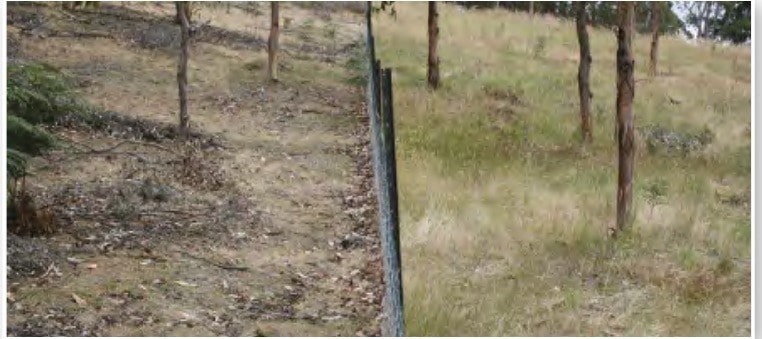
I’m sure you can work out which side the native wildlife is on. Public land mismanaged thus is just neglect – and animal cruelty. It is not something which should generate a warm inner glow!

It is equally absurd that whilst a landowner can easily obtain a permit to ‘cull’ an insignificant number of the troublesome wildlife (say a max of 10% – including eg up to five eagles, Really!) you are not allowed to make use of the carcasses in Victoria – you may not eat them or feed them to your dog, even compost them. They must be buried deeply. Who would comply with such absurd rules? Yet kangaroos taste quite good. I was brought up on them actually.
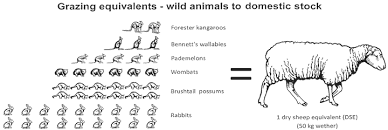
Usually I have used DM Plastics products to insulate the fence. They used to make a triangular sleeve (approx 815mm long) to insulate the 6:7:30 Waratah Hinge Joint or Ringlock. They plan to manufacture them again (but when?) Instead you will find that one of their ‘Maxidroppers’ will fit over a steel post and they have clips to match. Similarly ntheir Poly droppers and clips work fie for spacers. If you can’t buy them (out of stock right now – July 2018) you can cut 63mm lengths of 2″ rural poly and place them between two poly Pinlock insulators as in the photo below, which Is what i am having to do right now, as i urgently need the fence! The sections of poly pipe would be costing me A$1.60 plus the cost of the Pinlocks (but I have a heap of 2″ offcuts I can use from an earlier irrigation project), so the proprietary DM Plastics products work out just as cheap and a darn sight easier.
Measure
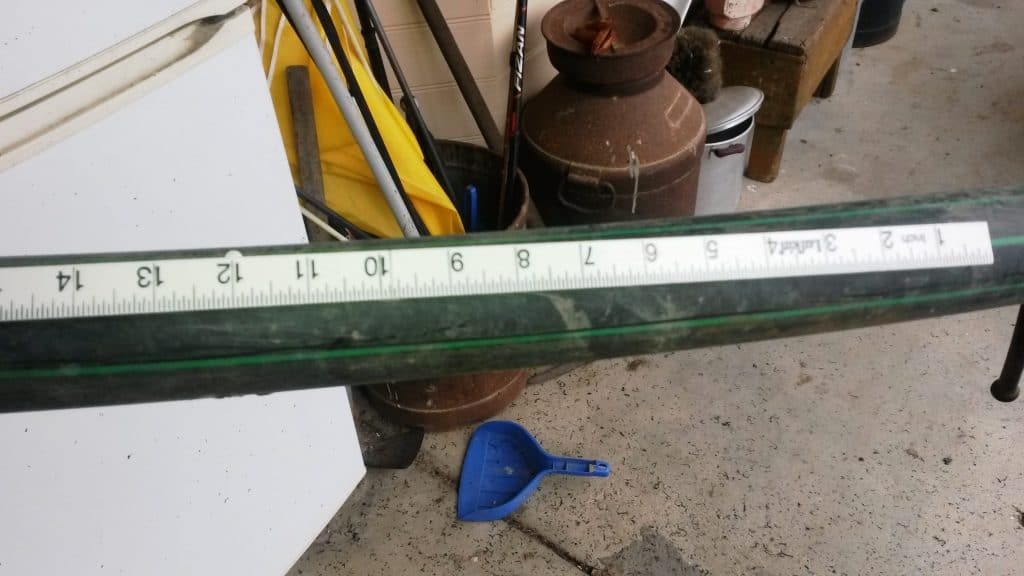
Cut
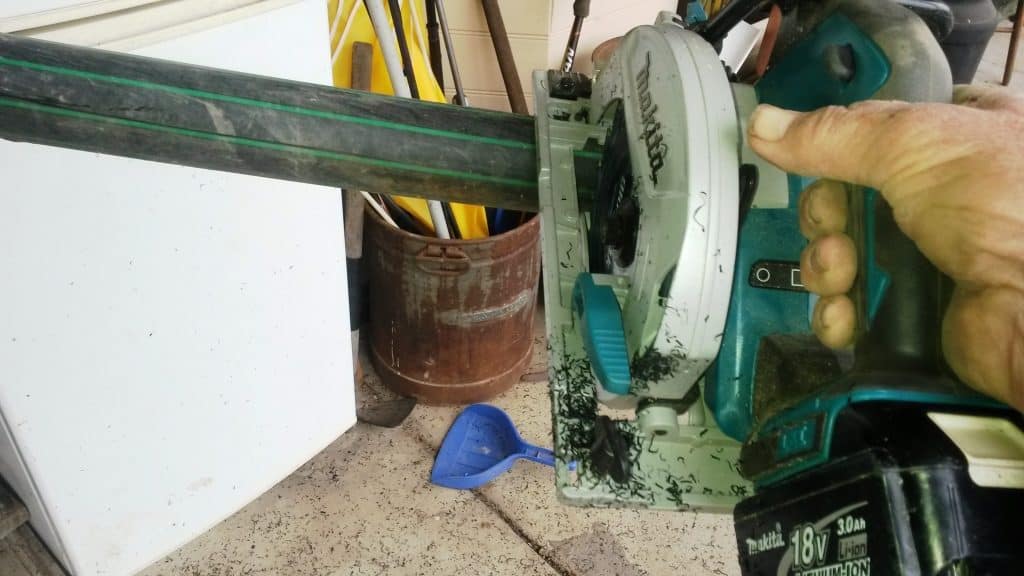
Stack
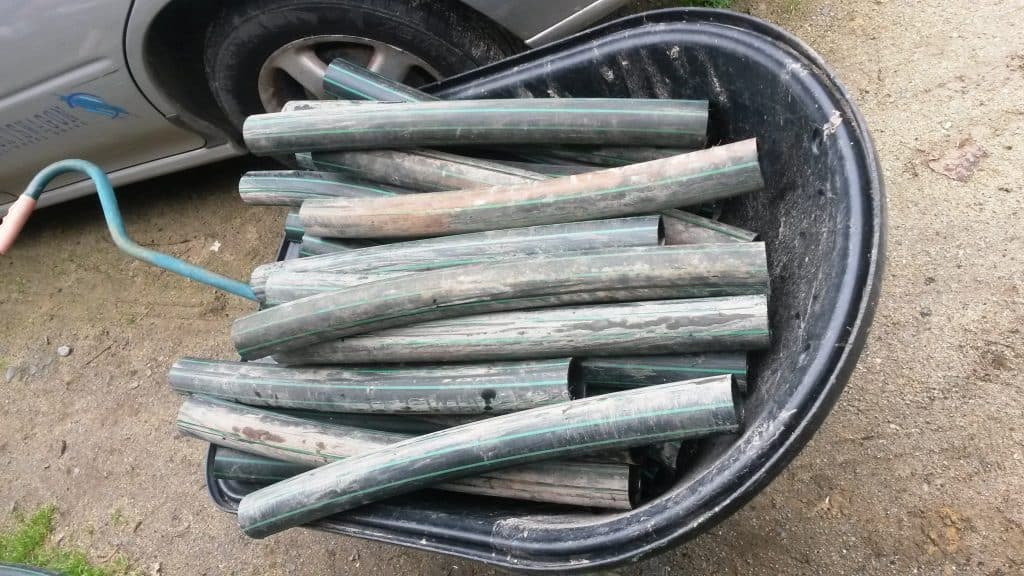
They attach like this.
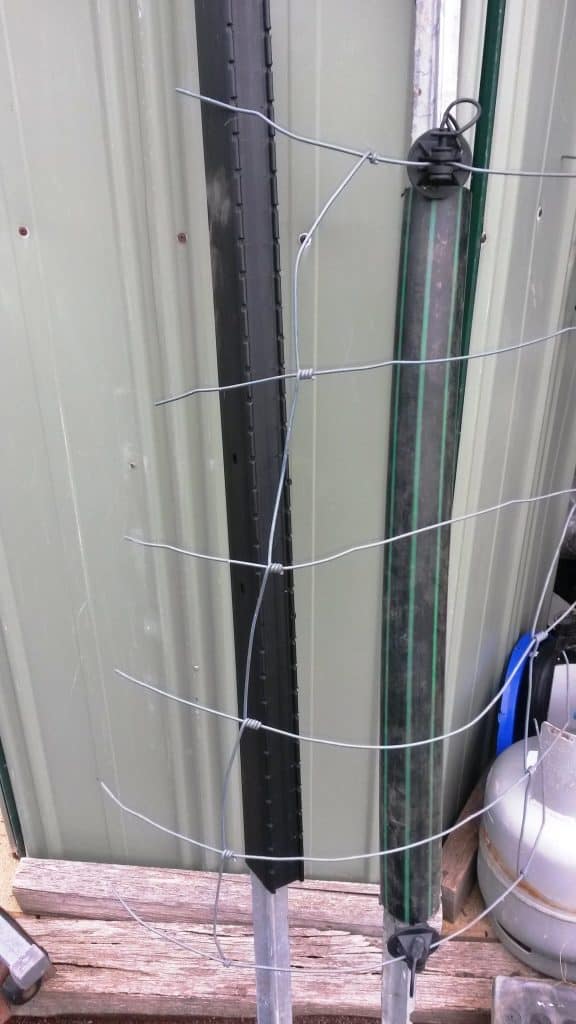
It is hard going on this bad knee though gradually working our way around the farm making paddock after paddock secure against pests and vermin, particularly as in places we have slopes of over 25 degrees!
I use the 1100 mm (DM) poly droppers as a guide to wire spacing. They have slots every inch for the wires (and proprietary clips) .The first earth wire goes up 1″, the second 3″. The Hinge Joint or Ringlock goes on another 3″ up which makes the first electric wire 6″ above the ground. This is just enough for sheep and wallabies to eat the grass on either side of the fence without getting zapped so that the grass does not short out the fence, but there is no way a fox or anything else can get through.
There is space above the woven wire for an earth wire 3″ up and another ‘hot’ wire another 3″ on the very top. I cut a steel post into three sections and drive it in at a 45 degree angle 90 degrees to the line of the fence underneath droppers which need pulling down. Then I can run a wire through the top hole of the cut-off post and pull the second bottom (earth) wire down to 1″ above the ground. Here and there I need to pin down a section of 1′ rabbit netting to prevent access of foxes/wombats. I put another hot wire on an outrigger on the outside top of the fence to further deter jumping critters like kangaroos. It works.
It is so pleasant to go out in the morning to let the ewes and lambs out of their vermin-proof night paddock/s and to count exactly the same number of lambs as went in the night before (and as we have tagged at birth). There is no profit at all in dead lambs, but folks from all over the world want to buy our Finnsheep. We could sell thousands every year if we had enough land, but we have retired onto just 25 acres after farming larger properties for many years, so they will just have to wait and accept the number we can produce. As ours are the best sheep in the world (probably), they will wait. See: http://www.finnsheep.com/index.htm
First Jul 6, 2018
See Also:


Hi, A very interesting and informative writeup about your Finnish Landrace sheep. I previously knew very little about them, in spite having farmed sheep all my life. I was once involved with trialing various new breeds when I worked with the Dept of Agriculture in New Zealand, at Invermay Research Centre, and I think Finns were one that they tried. Most of their trial work though was on using high fertility Booroola Merinos from Australia, and crossing them over NZ Romneys. The Booroola had the same high fertility genes as the Finns, but their mothering and milking ability was not very good, and they didn’t catch on much in NZ. We also had Texels ,which have proved a good breed for crossing with our Romneys. Coopworths are also a popular breed in NZ. as are Perendales. But the high country Merino still produces by far the most valuable fine wool in NZ. Other crossbred wool is hardly worth producing now, as it barely covers the cost of shearing. We badly need to find some new uses for our coarse wool that is piling up in our wool stores.
Hi Bruce, As you will see from our website (http://www.finnsheep.com/index.htm) we have improved the Finns enormously compared with the ones you saw in NZ back in the 1980s. These ones are long wools (23 microns) with the fertility, hardiness and mothering ability to make a good cross with Merinos. Maybe time to give them a go? Cheers, Steve & Della Jones.